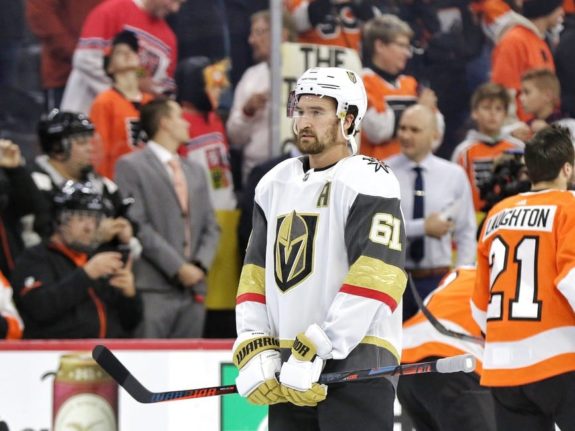In retrospect, the planned formula for the Vegas Golden Knights’ 2021-22 season was exceptionally arrogant in nature. While injuries to key contributors like Mark Stone, Max Pacioretty and Robin Lehner can’t be blamed on the organization, an impossibly tight cap sheet – made dramatically tighter by the Jack Eichel acquisition – has severely impeded their ability to ice a full lineup even when healthy. In a weak Pacific Division, this was part of the plan.
The Golden Knights never really sweated personnel losses or cap-related demotions (we won’t speculate on how “real” Stone’s current LTIR stint is) and, to be fair, it’s been working. Prior to being overtaken in the standings in mid-February by the surging Calgary Flames, Vegas had, as expected, reigned atop the division since early in the season. But now, seven points out of the Pacific lead and barely hanging onto a top-three playoff seed ahead of the Edmonton Oilers with under 30 games to play, the club has never looked more vulnerable.

Sporting an underwhelming 10-9-4 record since the start of the calendar year, the Golden Knights suddenly find themselves slipping from Cup contender to postseason question mark. What’s happening here?
Offense Gone Cold
That $26.5 million top line of Eichel, Stone and Pacioretty looks positively lethal on paper, but who knows when we might ever see it in action out on the ice? Instead, the team’s recent slide has revealed an inability to consistently generate offense from a group that has ranked seventh in goals scored across the entire league since entering the NHL. Since the calendar turned to 2022, the Golden Knights have averaged just 2.65 goals per game (61 goals in 23 games).
Special teams hasn’t helped matters, either. The Vegas power play currently ranks 23rd in the league, with a mere 18.1% efficacy rate. While there might be a temptation to shrug this off by citing injuries, there remains enough healthy firepower here with Eichel, Pacioretty, Jonathan Marchessault, Reilly Smith and power-play quarterbacks Shea Theodore and Alex Pietrangelo that the man advantage should probably be more advantageous than its been.
Fortress Failures
Eight, eight, eight, six. That is the Golden Knights’ league-wide home record rank, by points percentage, in each of their first four years of existence. Thus far, in year five, the club’s .547% points percentage at T-Mobile Arena is currently only good for 19th, a significant drop for a celebrated arena that has come to be known as the Fortress.

Thanks to COVID-related postponements back in January, the Golden Knights actually wound up with a stretch of eight home games in a row starting on New Year’s Eve. But what should’ve been a prime opportunity to create distance in the Pacific ultimately resulted in just three wins and nine out of 18 points.
Depth Questions
During the Golden Knights’ storybook expansion season, the club built a ‘next man up’ ethos predicated on the idea that, on a team comprised of unwanted cast-offs, the opportunity is there for anyone to step up. It goes without saying that the organization is no longer comprised of cast-offs and, thus, that mentality no longer exists. But even as this is unquestionably a more talented team than the 2017-18 group, the lack of that belief among depth players has hurt.
You may also like
- 9 NHL Teams That Missed in Free Agency
- Golden Knights Will Miss Jonathan Marchessault
- Islanders’ Lamoriello Needs to Follow Golden Knights’ Ruthless Trade Model
- Golden Knights Struggling to Address Voids in Forward Corps
- Golden Knights Took Major Risk With 1st-Round Pick Trevor Connelly
The rash of injuries the organization has suffered through, particularly at the top of the lineup, simply haven’t resulted in significant help from secondary sources to fill the void. William Karlsson has picked a sub-optimal time for his worst season in black and gold. Even Chandler Stephenson, a bright spot over the season’s first half, has cooled considerably, managing just two goals and two assists over his past 14 games, a drop in production right in line with his shift down the depth chart upon Eichel’s arrival.
Now, Stephenson finds himself lining up alongside bottom-six players that have struggled mightily. Nicolas Roy’s slight bump in production can mostly be attributed to averaging three more minutes of ice time per game. Meanwhile, Mattias Janmark (re-signed) and Nolan Patrick (acquired via trade) both look like off-season misfires with just 23 points combined.
Golden Knights’ Postseason Outlook
It’s not too late for the Golden Knights to turn things around, and that could be at least partially attributed to their place in the Pacific. If Vegas resided in the Eastern Conference, they would currently be out of the playoff picture entirely and already eight points out of either divisional top-three. Instead, they currently occupy the third spot in the Pacific and, if the season ended today, would fall into a very winnable first round series against the Los Angeles Kings.
In truth, the club probably isn’t fretting much about playoff seeding or potential match-ups. Aside from maybe the Colorado Avalanche, whom Vegas beat in the second round of the playoffs last spring, there isn’t one opponent in the West who would prove overly daunting with the Golden Knights at full strength. Of course, that ‘full strength’ caveat is key, as the status of Stone and, to a lesser extent, guys like Alec Martinez and Brayden McNabb will factor heavily.
In the meantime, the biggest challenge of the postseason will be getting there. The Golden Knights are just kicking off a tough Eastern trip and will be home for only nine of their remaining 25 games (which may be a blessing in disguise). The Oilers, meanwhile, sit four points back but have 15 home games remaining and carry plenty of desperation while boasting the league’s top two leading scorers in Leon Draisaitl and Connor McDavid. Things are about to get interesting!
